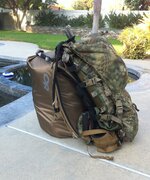XPac is NOT waterproof.
To clear this up, X-Pac IS waterproof. Most of the X-Pac fabrics we use are rated to 160 to 200 psi water resistance, meaning that most pressure washers can't force water through the laminate.
Stitch holes, cordura, wicking webbing, etc, are NOT waterproof and can allow water to penetrate through seams. Good seam sealing technique solves this for most users. In extreme uses like packrafting, drybags for critical gear are a good idea.


